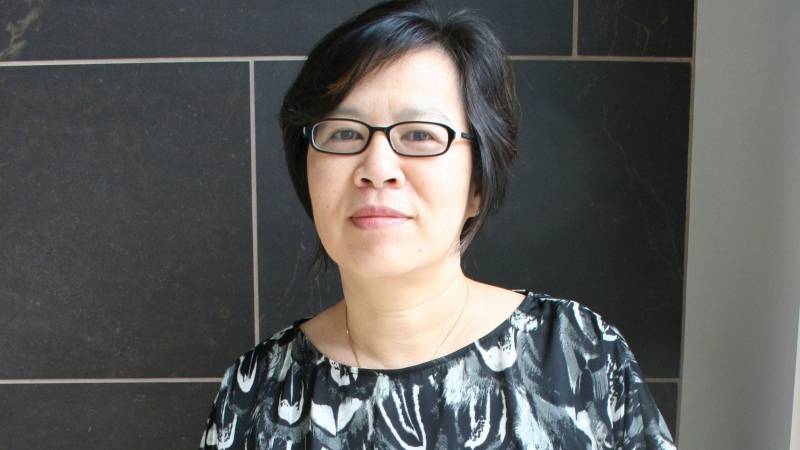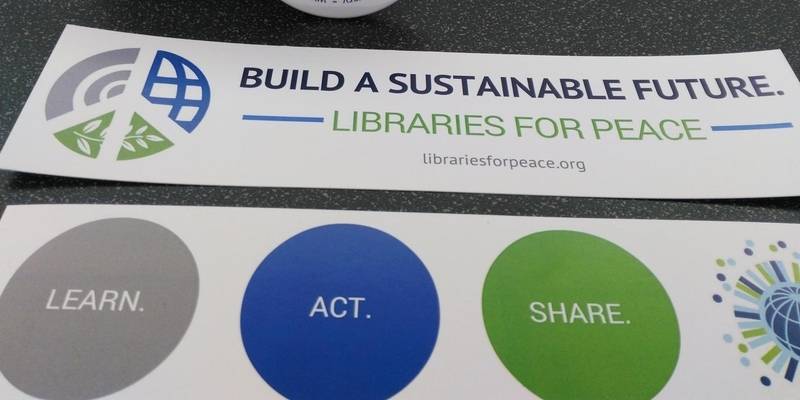Libraries for Peace is an annual event focused on creating connections and ties between libraries around the world, and fostering international awareness within the general public. The event promotes international education, peace, and overall understanding, and uses social media and other forms of technology in order to help the community learn more about how our libraries can change so much of our daily lives. The Mortenson Center and the community will come together on September 21st in order to help act on their pledge to create social change and greater peace.
The Mortenson Center for International Library Programs, part of the University of Illinois Library, offers non-degree professional development programs for librarians that are outside the United States. There are many international ties for the programs and the center is heavily focused on extending those ties to create a more universal impact for libraries around the world.
According to the Libraries for Peace website, “The Libraries for Peace (L4P) initiative promotes the role of libraries to advance peace internationally. This website and social media provide resources for libraries and others to learn about what libraries are doing to promote peace, how they can initiate their own efforts, and where these actions are taking place; to discuss and share ideas of libraries and peacebuilding; and to serve as an information hub for an international library celebration and action day for peace.” I was able to get in touch with Dr. Clara M. Chu, Director of the Mortenson Center, and she elaborated thoroughly on the annual event and how it has affected and helped create greater awareness across a large platform in such a short amount of time.

Smile Politely: How did Libraries for Peace come about? How was it originally created and why?
Dr. Clara Chu: In 2014 when considering the position of Director and Mortenson Distinguished Professor of the Mortenson Center for International Library Programs that I now hold at the University of Illinois Library at Urbana-Champaign, I was attracted to the overall mission of the Center. The Center’s mission is to strengthen international ties among libraries and librarians worldwide for the promotion of international education, understanding, and peace. I was drawn to the opportunity to make more explicit the promotion of peace by building on the excellent work that the Center does on developing library leaders worldwide. In 2016 we launched the Libraries for Peace (L4P) initiative to promote the role of libraries to advance peace internationally after gathering resources on what libraries were doing to advance peace and ways after gathering resources on what libraries were doing to advance peace, and ways to collectively promote, support, build on and celebrate peace building by libraries globally. It includes the web portal and Facebook page, which provide resources for libraries and others to learn about what libraries are doing to promote peace, how they can initiate their own efforts, and where these actions are taking place; to discuss and share ideas of libraries and peacebuilding; and to serve as an information hub for an international library celebration and action day for peace. This Libraries for Peace (L4P) Day calls on libraries and librarians around the world to annually observe International Day of Peace on 21 September, and to pledge to act to advance peace.
SP: Libraries for Peace is using a lot of technology to get their message across and help create better awareness to a larger audience. What is the importance of using technology in order to create this positive awareness on peace?
Chu: Technology is important for its 24/7 access to information and communication, both synchronous and asynchronous interaction, and expanding our global and multilingual reach. Although we are aware that there are many people as well as libraries in rural areas in the world that still do not have reliable or cannot access the internet, this condition is slowly improving. For those who do have access to the internet, in an asynchronous mode, they can access resources, share their activities, engage in dialogue about what peace means, and pledge to advance peace. Libraries who share their activities do so either by submitting an entry of their peace celebration or work that is automatically mapped on our asset map and can be browsed and searched by others looking for ideas. Asynchronous engagement is possible with the use of a Padlet inserted on the website with a question for anyone to contribute a comment in text, audio or video format. We also encourage information sharing using different hashtags including #librariesforpeace #peaceday #librariesforpeacestory.
In a synchronous mode we offer Minitalks/Minicharlas webinars, in partnership with Kate Williams at the iSchool of Illinois. We are expanding the coverage with talks in Spanish with a focus on social aspects of “libraries, literatures, literacies :: bibliotecas, literaturas, alfabetizaciónes.” This partnership began in Fall 2017.
For multilingual access, we have placed the Google translator widget on our website to allow people to access the textual content in the languages available on the Google translator.
SP: What usually occurs on the International Day of Peace and how do all libraries take part in this event?
Chu: On International Day of Peace which is takes place annually on September 21st, libraries are invited to celebrate Libraries for Peace (L4P) Day in observation of International Day of Peace with the world community. Librarians, libraries and friends are invited to:
1. ADD your celebration to the L4P map and tour the map to find celebrations worldwide.
2. Use SOCIAL MEDIA to share your event with the hashtags #librariesforpeace #peaceday
The United Nations General Assembly has declared International Day of Peace as a day devoted to strengthening the ideals of peace, both within and among all nations and peoples. The theme for the International Day of Peace in 2018 is “The Right to Peace — The Universal Declaration of Human Rights at 70.” The theme celebrates the 70th anniversary of the Universal Declaration of Human Rights. While Article 3 of the Universal Declaration of Human Rights states “Everyone has the right to life, liberty and security of person,” it does not include a separate article on the “Right to Peace.” This is why the United Nations asks: What does “The Right to Peace” mean to you? And we ask: How can libraries support “The Right to Peace”? Share your ideas with us through #librariesforpeace #peaceday or #standup4humanright and discuss the topic directly on this padlet.
SP: The annual event has reached a massive audience already and is continuously growing. Do you have any concrete examples of the libraries showing and or promoting peace in their environment that you found to be significant?
Chu: On the Libraries for Peace map, under stories, Peter Johan Lor contributed his list of “Libraries promoting peace” while researching what peace really means and what libraries in various countries are doing to contribute to promoting peace. Other stories include:
The Grace Fellowship Community Library, a Community Library in a slum community in Kampala, the capital City of Uganda, was shared by Lois Nankya Mutibwa and Ronald Sentuwa. This community library was setup at Grace Fellowship Nursery and Primary school to improve on the literacy levels of children in Kampala District. This was part of an initiative of Children International – Uganda in partnership with East African School of Library and Information Science, Makerere University and other partners like National Library of Uganda, Kampala City Council Authority and the Uganda Children Writers and Illustrators Association. This library was stocked with resources like books (donated by Book Aid International) toys, mats and they were painted and fully furnished. One teacher was appointed to volunteer as the Librarian. A committee of six community members was appointed to provide support for the library. The library holds reading tents in order to market the library and encourage children to read. The teachers were trained in library management and were also able to visit other libraries to learn best practices.
The One Thousand Origami Cranes Project by the Library of the Universidad de Cantabria, Spain, commemorated the 70th anniversary (2015) of the bombing of Hiroshima, with a message of peace through one thousand origami cranes hanging in the library for anyone to view. They also had a small campaign on their website, and local press and TV. Silvia Sanz noted that no cost was involved as the staff made the 1000 origami cranes in their free time.
SP: The event has already helped in creating greater awareness, but is there anything else the general public can do to help more people get involved? How can the overall community come together to work in promoting Libraries for Peace?
Chu: The overall community can come together by engaging in peacebuilding and sharing their stories on our map, celebrating Libraries for Peace Day and adding their celebrations on our map, by using the L4P website as an information resource, and by considering libraries as community anchors that is a space for community engagement.
SP: Is there anything about the annual event or the Mortenson Center that is significant to the public or that you would like to elaborate on?
Chu: The Mortenson Center also works on projects related to advancing peace, sustainability and social transformation. One that is has completed in partnership with the American Library Association, with major funding from the Institute of Museum and Library Services is Project Welcome: Libraries and Community Anchors Planning for Resettlement and Integration of Refugees and Asylum Seekers. This project learned about ways libraries can address the information needs of refugees and asylum seekers in order to support and empower them in their resettlement and integration process, and created a guide for public libraries.
Community-Library Inter-Action (CLIA) is a current project which invites libraries to facilitate local dialogue and community action. In this context libraries contribute to the collective action and impact on the part of libraries worldwide to advance peaceful and sustainable communities. CLIA is a collaborative project which builds on the experience of the Mortenson Center developing librarians worldwide, including its Libraries for Peace initiative, and the international expertise of the University of Lincoln and the Take Part Research Cluster in community-based research, including the Take Part Learning Framework for Active Citizenship Learning. It is coordinated by myself and Zoraida Mendiwelso-Bendek (University of Lincoln, UK). CLIA processes enable libraries to strengthen their role as community anchors by working WITH, not just FOR communities and by being socially rather than goal-driven.
To learn more about the work of the Mortenson Center, or become involved with the International Peace Day on September 21st, please visit their website.
Photos from the Libraries for Peace Facebook page








